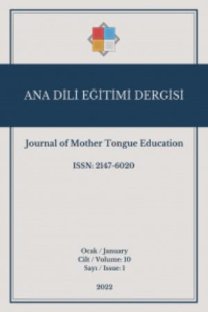An Analysis of the Accusative Case Use of Learners of Turkish as a Foreign Language
Yabancı Dil Olarak Türkçe Öğrenenlerin Belirtme Durumu Kullanımlarının İncelenmesi
___
Yeni Hitit Yabancılar İçin Ders Kitabı 1. Ankara: Ankara Üniversitesi.Tokdemir Demirel, E. (2017). Detection of Common Errors in Turkish EFL Students’ Writing Through a Corpus Analytic Approach. English Language Teaching, 10(10), 159-178. İnternet’ten 21 Nisan 2018’de http://www.ccsenet.org/journal/index.php/elt/article/view/70748 adresinden alınmıştır.
Tahaineh, Y. S. (2011). Arab EFL University Students’ Errors in the Use of Prepositions. Modern Journal of Applied Linguistics, 1(6), 76-112. İnternet’ten 21 Nisan 2018’de https://www.researchgate.net/publication/261961452_The_use_of_prepositions_by_Arab_EFL_learners_Looking_on_the_bright_side adresinden alınmıştır.
Stapa, S. H. & Izahar, M. M. (2010). Analysis of Errors in Subject-Verb Agreement Among Malaysian ESL Learners. 3L The Southeast Asian Journal of English Language Studies, 16(1), 1-18. Internet’ten 21 Nisan 2018’de http://ejournal.ukm.my/3l/article/view/1005 adresinden alınmıştır.
Pèrez Sànchez, A. M. (2013). A Corpus-based Analysis of Errors in Adult EFL Writings. Revista Nebrija de Lingüistica Aplicada, (2013) 13. İnternet’ten 21 Nisan 2018’de http://www.nebrija.com/revista-linguistica/a-corpus-based-analysis-of-errors-in-adult-efl-writings.html adresinden alınmıştır.
Parker, F. & Riley, K. (2005). Linguistics for Non-Linguists: A Primer with Exercises. 4th Edition. USA: Pearson.
Ozcan, M. (2012). Novelists Call Out Poemists: A Psycholinguistic and Contrastive Analysis of the Errors in Turkish EFL Learners’ Interlanguage. World Academy of Science, Engineering and Technology International Journal of Cognitive and Language Sciences, 6(8), 2311-2322. İnternet’ten 21 Nisan 2018’de https://waset.org/Publication/novelist-calls-out-poemist-a-psycholinguistic-and-contrastive-analysis-of-the-errors-in-turkish-efl-learners-interlanguage/2632 adresinden alınmıştır.
Muhsin, M. A. (2016). Analysing the student errors in using simple present (A case study at Junior High School in Makassar). Pacific Science Review B: Humanities and Social Sciences, 2(2016), 81-87. İnternet’ten 21 Nisan 2018’de https://www.sciencedirect.com/science/article/pii/S2405883116300314 adresinden alınmıştır.
Lewis, G. (2000). Turkish Grammar (2nd Edition). Oxford: Oxford University Press.
Kornfilt, J. (1997). Turkish. Great Britain: Routledge.
Kim, J. E. & Yoo, I. W. (2015). A Corpus-based Study of To-Infinitive Errors in Korean College Freshmen’s Writing. The Journal of Asia Tefl, 12(4), 37-60. İnternet’ten 28 Ocak 2018’de http://www.asiatefl.org/main/main.php?main=6&sub=5&submode=3&inx_journals=46&inx_contents=420 adresinden alınmıştır.
Göknel, Y. (2014). English Turkish Grammar: Functional & Transformation. United Kingdom: Vivatinel.
Ergin, M. (2000). Türk Dilbilgisi. İstanbul: Bayrak Yayınları.
Ellis, R. & Barkhuizen (2005). Analysing Learner Language. Oxford: Oxford University Press.
Divsar, H. & Heydari, R. (2017). A Corpus-based Study of EFL Learners Errors in IELTS Essay Writing. International Journal of Applied Linguistics & Literature, 6 (3), 143-149. İnternet’ten 21 Nisan 2018’de http://www.journals.aiac.org.au/index.php/IJALEL/article/view/3052 adresinden alınmıştır.
Dagneaux, E., Denness, S., & Granger, S. (1998). Computer-aided error analysis. System, 26, 163–174.
Corder, S. P. (1981). Error Analysis and Interlanguage. Oxford: Oxford University Press.
Can, C. (2017). A Learner Corpus-based Study on verb errors of Turkish EFL learners. Journal of Education and Training Studies, 5(9), 167-175. İnternet’ten 21 Nisan 2018’de https://files.eric.ed.gov/fulltext/EJ1151945.pdf adresinden alınmıştır
Brown, H. D. (2000). Principles of Language Learning and Teaching (Fourth Edition). New York: Pearson Education.
Brezina, V.& McEnery, T., Wattam, S. (2015). Collocations in context: A new perspective on collocation networks. International Journal of Applied Linguistics, 20(2), 139-173.
Bölükbaş, F. & Gedik, E. & Gönültaş, G. & Keskin, F. & Fazilet Ö. & Tokgöz, H. & Ünsal, G. (2012). Istanbul Turkish for Foreigners Coursebook A1. İstanbul: Kültür Sanat Basımevi.
Babanoğlu, M. P. (2014). A Corpus-Based Study on the Use of Make by Turkish EFL Learners. International Journal of Education & Literacy Studies, 2(2), 43-47. İnternet’ten 21 Nisan 2018’de http://www.journals.aiac.org.au/index.php/IJELS/article/view/410 adresinden alınmıştır.
- ISSN: 2147-6020
- Yayın Aralığı: 4
- Başlangıç: 2013
- Yayıncı: Mehmet Kurudayıoğlu
Yabancı Dil Olarak Türkçenin Öğretiminde Duygu Durumu Bildiren İfadelerin Öğrenilme Düzeyi
Yabancı Dil Olarak Türkçe Öğrenenlerin Belirtme Durumu Kullanımlarının İncelenmesi
İlkokul Türkçe 1 Ders Kitabının Öğretim Programındaki Temel Beceriler Açısından İncelenmesi
Mehmet KURUDAYIOĞLU, Taşkın SOYSAL
2018 Cilt:6 Sayı:3 Jenerik Dosyası
İlkokul 2. Sınıf Öğrencilerinin Süreç Temelli Yazma Uygulamalarına İlişkin Görüşlerinin İncelenmesi
ÖMER FARUK TAVŞANLI, ABDULLAH KALDIRIM
Okuma Çemberleri: Niçin ve Nasıl? Örnek Bir Uygulama
BİRSEN DOĞAN, KASIM YILDIRIM, HÜLYA ÇERMİK, SEYİT ATEŞ
Türkçe Öğretiminde Kaynak Metinlerin Kullanılmasına Uygun Durumların Oluşturulması
Beyin Araştırmaları Işığında Yabancı Dil Sınıflarında Anadili Kullanımı
